Farm housing is rewarding and exciting when you rear your favorite animals. But have you ever thought of keeping different animals in the same place?
Can animals such as pigs and goats live together harmoniously? How risky is it?
This article gives you seven tips on keeping pigs and goats together. We also examine whether they share the same feeds and have common diseases. Keep reading!
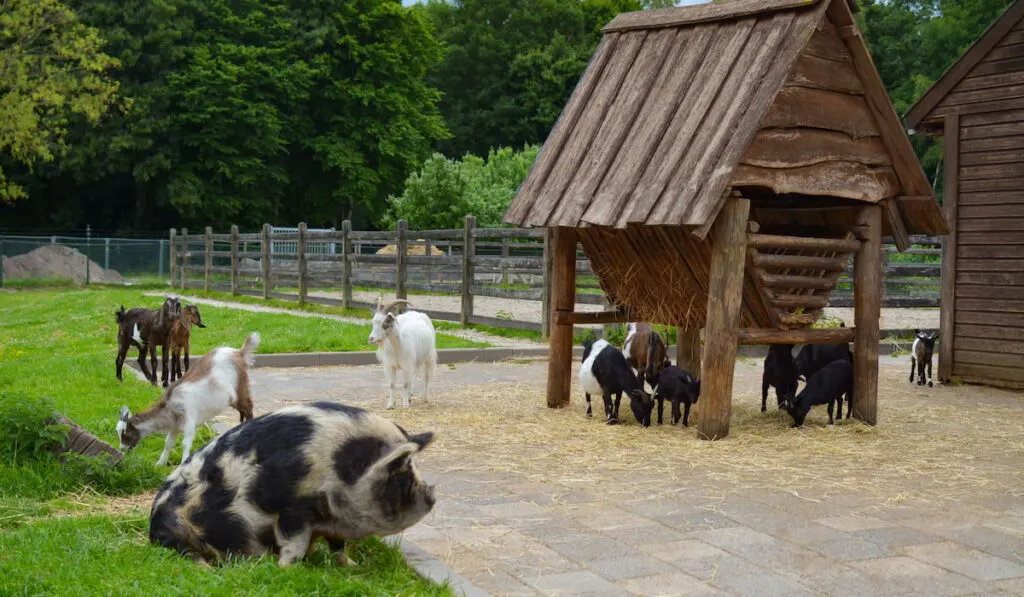
Table of Contents
Can Pigs and Goats Live Together?
While this may seem like a yes or no question, it could be more precise. Pigs and goats can harmoniously live together if you observe some precautions. But, like many other animals, problems may arise when goats and pigs live nearby.
Can They Share the Same Feed?
Pigs and goats have different nutritional requirements and feeding habits and can’t share the same feed.
- Pigs are omnivorous, and goats are herbivores.
- Unlike pigs, goats feed on tender twigs, leaves, shoots, and other plant materials.
- Some pig feeds can be quite toxic to goats, making them sick and even capable of leading to death. Goats have sensitive digestive systems; a little imbalance, such as the medicated pig feeds, could cause problems.
- Goat feeds may not have sufficient nutrients for pigs. For instance, pigs have higher protein requirements than goats. The table below shows the protein requirement for goats compared to pigs.
| Weight of animal | % of protein requirement for goats | % of protein requirement for pigs |
| Weaning (up to 29.9lbs/13.6kg) | 14 | 22 |
| Weaner (up to 59.9/27.2kg) | 12 | 18 |
| pregnant | 11 | 16 |
| lactating | 11-14 | 15 |
| Bucks and boars | 11 | 14 |
Therefore, when you keep pigs and goats together, ensure you feed them separately and remove any leftover feeds. Some common food ideas include hay, fruits, seeds, vegetables, and grains.
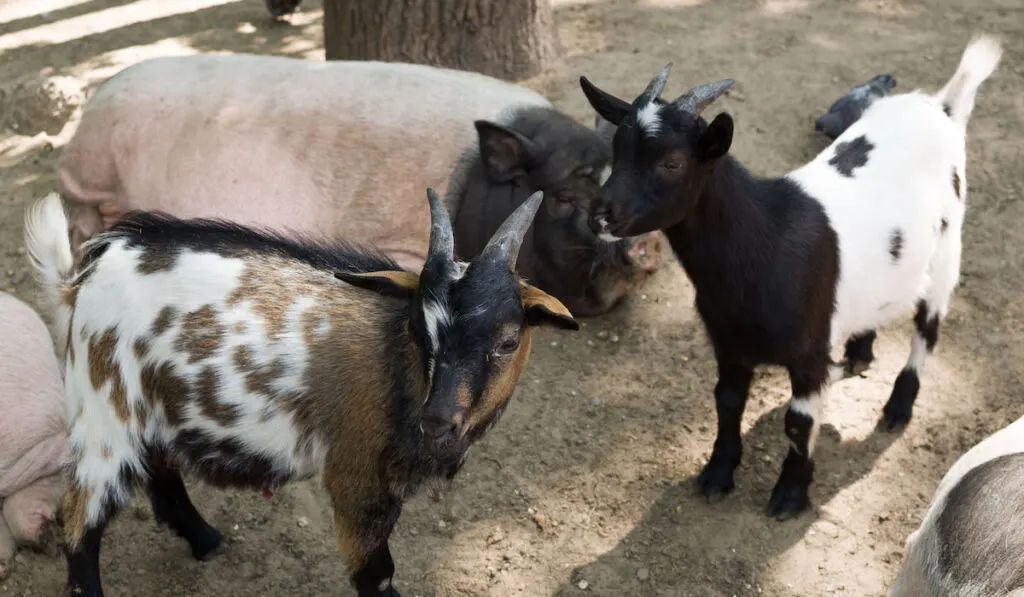
Do They Have Any Common Diseases or Parasites to Be Wary Of?
Parasites and diseases in pigs and goats are not uncommon. Avoiding diseases and parasites is almost impossible.
But reducing the risks and identifying and treating infections will improve your animals’ health and safety.
Some common diseases and parasites to be wary of include:
- Tapeworm: young pigs and goats are susceptible to tapeworm infestation, which can lead to stunted growth or severe colic.
- Lice: are external parasites that infest domestic animals, including pigs, sheep, goats, and cattle, leading to chronic dermatitis.
- Brucellosis: is a bacterial infection affecting humans and livestock, leading to weakness and loss of appetite.
- Mastitis: is a mammary inflammation that causes abnormal milk production and pain.
- Mange is a highly infectious skin disease affecting domestic animals and humans. It can lead to skin lesions, persistent dermatitis, pruritus, and other skin conditions.

Will Pigs and Goats Get Along?
It’s not definite whether they get along since they have different personalities and temperaments. But if you think about the species as a whole, pigs generally love having their own space and enjoy the company of other pigs.
Therefore, if other pigs are around, they won’t get along with goats as they are likely to stick with other pigs.
Pigs are pretty aggressive animals and love dominance. In doing this, they can hurt or even kill other animals, especially baby goats.
Moreover, pigs are omnivorous and like to feed on meat besides plants. Therefore, you must take some precautions if you want to keep them together.
On the other hand, goats are generally calm, social, and friendly and will get along with most animals, including cows, horses, and sheep. But they may still be afraid of being near other animals.
Also, they may eat other animals’ feeds, leading to conflicts. Hence, ensure you keep an eye on them and have enough resources and space.
Things to Look Out for When Keeping Pigs and Goats Together
Keeping pigs and goats together is less fun and easy than you think, especially if you don’t take the necessary precautions. A few apparent mistakes can cost you the health or life of your animals. Below are tips to help you rear pigs and goats peacefully:
1. Consider the Breeds of Your Pigs and Goats
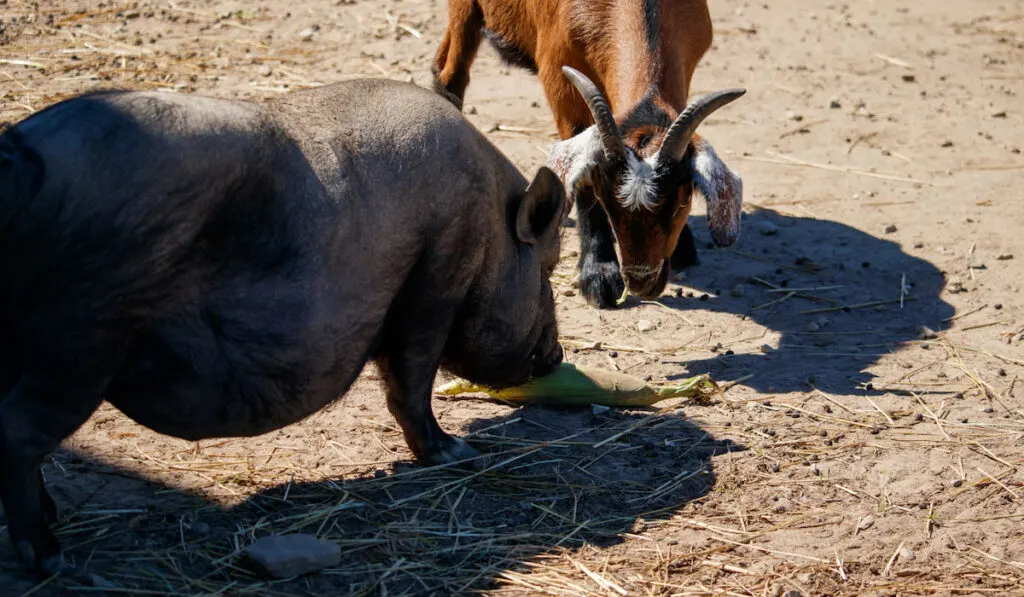
Did you know that pigs and goats have various breeds within each species? For example, some goat breeds are known to be quite aggressive compared to others. At the same time, some pig breeds can behave like their wild cousins.
To avoid constant attacks between your animals, ensure you rear the non-aggressive breeds of both species.
For example, some non-aggressive goat breeds to raise with pigs include:
- Kiko
- Nigerian dwarf
- Alpine
- Nubian
- Boer
Some easier pig breeds to raise with goats include:
- Landrace
- Middle White
- Berkshire
- British lops
- British saddleback
2. Consider the Differences in Feeding Behaviors
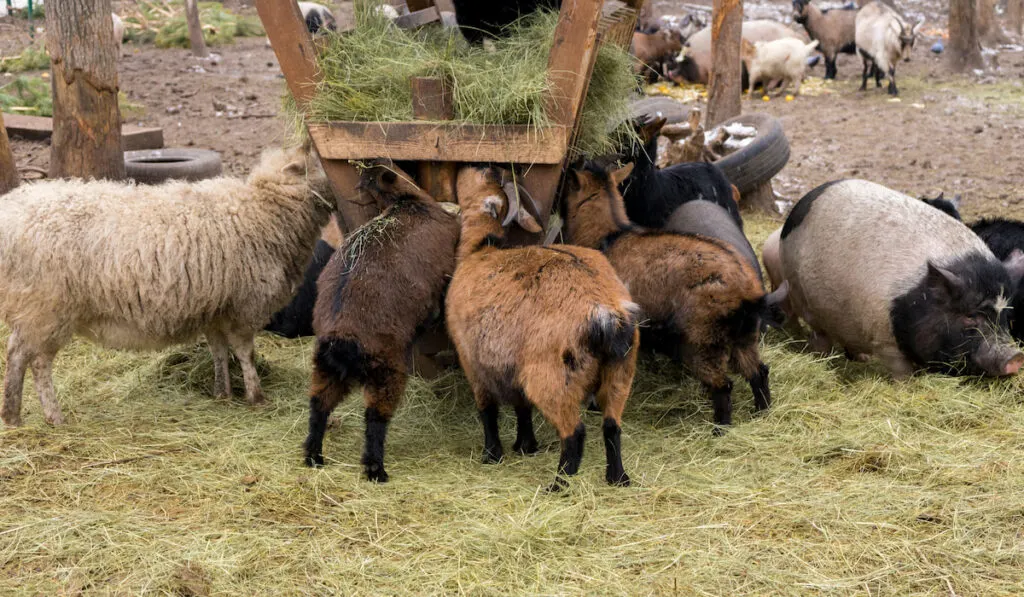
Goats are herbivores and search for grass, leaves, and leafy things that they can feed on. Pigs are omnivores and tend to destroy plants and animal products they come across.
Therefore, ensure you allow your pigs and goats to search for their natural foods. And if you must feed them processed food, separate them.
3. Partition Your Animals’ Housing
When keeping pigs and goats together, housing them is relatively easy. Pigs need approximately 16-40 square feet per pig in their barn. Goats require about 15 square feet per goat.
Also, minimize interaction between your animals when not watching them, especially at night.
4. Prevent Competitions and Fights
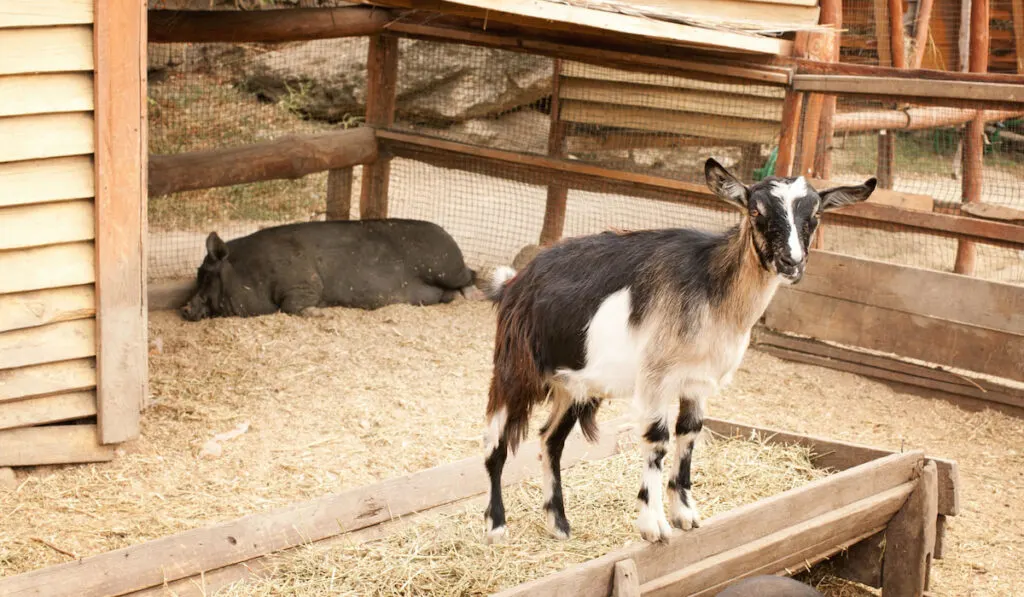
The first step to avoiding fights and competitions between your pigs and goats is to raise non-aggressive breeds, as discussed above. Other helpful tips include:
- Have adequate space. The larger the pen or barn, the less contact the goats and pigs will have; hence fights will be less often.
- Ensure you have enough food so as to reduce competition.
- Raise your pigs and goats together as weanlings. When you keep your pigs and goats together from a very young age, they’ll grow up to be friendly and familiar with each other.
Impressive tips, right? Always do all you can to prevent competition and fights between your pigs and goats.
5. Prevent Transmission of Diseases
Pigs and goats share common diseases such as nematodes, fungal infections, bacterial diseases, viruses, etc. Therefore, the probability of disease transmission between them is very high.
Here are a few hacks and tips to prevent disease and parasite transmission:
- Have sufficient space. We must uphold the importance of large spaces. The larger the area, the less contact between your animals, reducing disease transmission risks.
- Isolate sick and weak animals, treat them and ensure they are healthy before returning them to the shared space.
- Contact your vet whenever you see unusual symptoms in your animals.
6. Isolate Mother and Baby Goats from Pigs
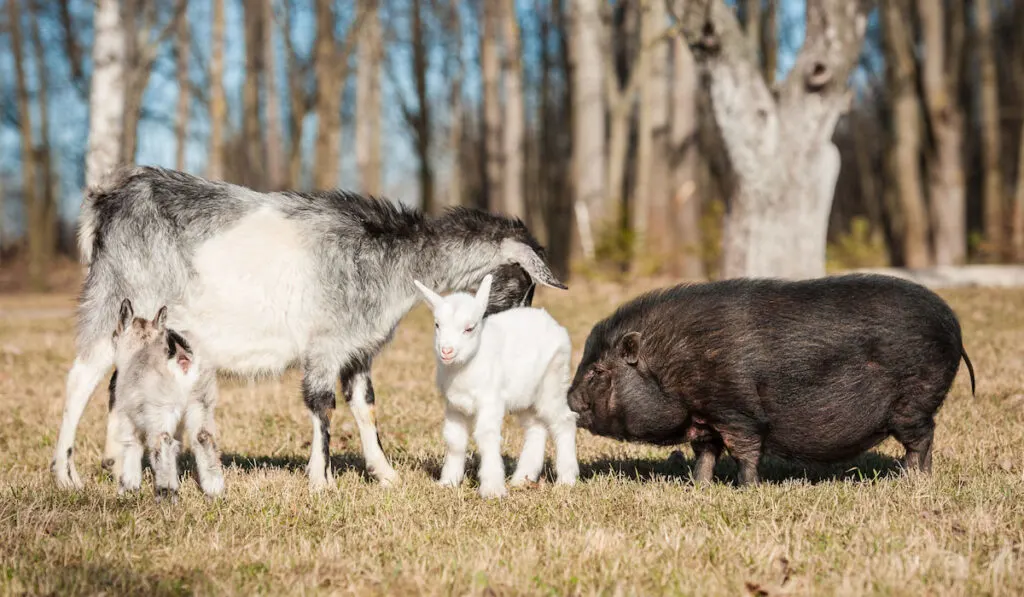
Pigs are known to attack lactating goats. Besides, due to their omnivorous nature, they may eat your goat’s kids if left unattended. Therefore, ensure you keep both separate from the pigs.
Also, keeping baby goats separated helps prevent them from contracting diseases and parasites.
7. Fence the Perimeter
Pigs are naturally destructive; hence you should ensure that the space is well-secured to prevent them from escaping. Furthermore, having a secure perimeter keeps away predators and thieves.
Conclusion
Pigs and goats can coexist, provided the shared space is large enough with ample resources. But always remember that pigs like dominance and should have limited interactions with goats.
So, if you keep pigs and goats together, define clear boundaries between them and keep an eye on them. Also, seek your vet’s guidance on which breeds are best for raising together.
Hopefully, the above tips will help you enjoy keeping pigs and goats together!
Resources
I wrote this article using my experience raising pigs and goats and the following sources:
- https://content.ces.ncsu.edu/nutritional-feeding-management-of-meat-goats
- https://www.mofga.org/resources/pigs/pigs/
- https://opensanctuary.org/how-pigs-get-along-with-other-species/
- https://opensanctuary.org/how-goats-get-along-with-other-species/
- https://extension.psu.edu/raising-small-groups-of-pigs
- https://shareok.org/bitstream/handle/11244/319895/oksa_epp_7019_2015-06.pdf?sequence=1&isAllowed=y
- https://www.mayoclinic.org/diseases-conditions/brucellosis/symptoms-causes/syc-20351738
- https://ufhealth.org/echinococcosis
- https://www.agriculture.com/livestock/6-reasons-to-love-llamas
- https://extension.psu.edu/programs/courses/meat-goat/basic-production/general-overview/goat-housing-and-facilities
- https://porkcheckoff.org/pork-branding/facts-statistics/major-swine-breeds/
- https://mysrf.org/pdf/pdf_swine/s1.pdf
- https://farmgrid.org/mastitis-in-gilts-and-sows/
- https://www.woah.org/fileadmin/Home/fr/Health_standards/tahm/3.09.07_MANGE.pdf
- https://extension.okstate.edu/fact-sheets/external-parasites-of-goats.html
